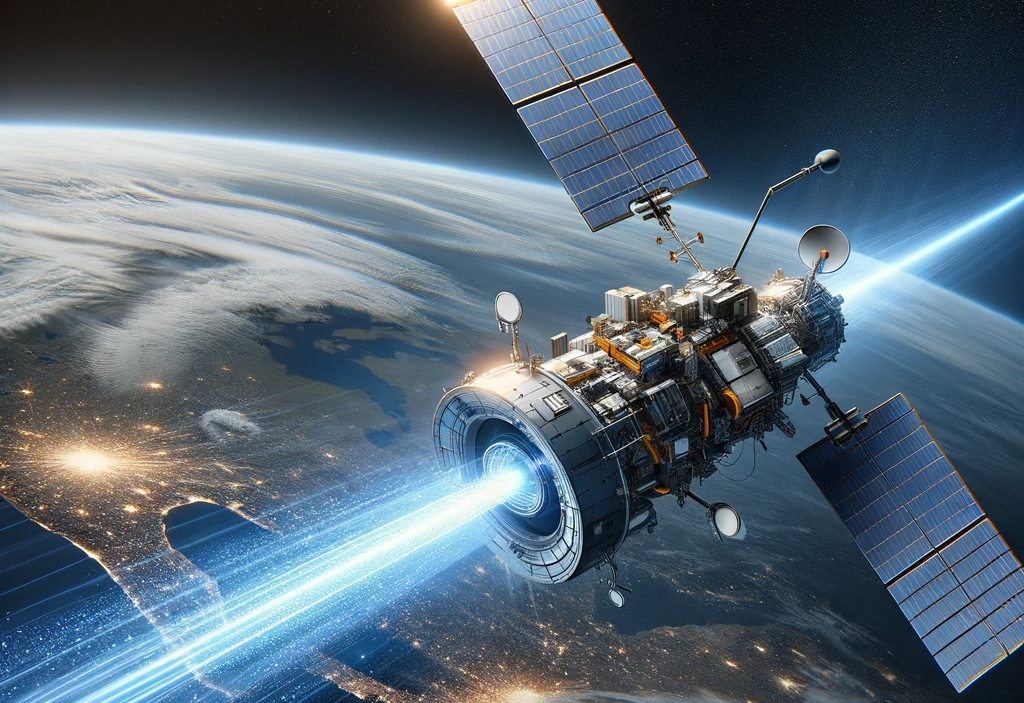Exploring faster-than-light (FTL) communication, a concept rooted in science fiction has intrigued scientists and engineers for years. The proverbial little brother to FTL travel, where a spacecraft is sent at warp to a distant location, FTL communication may be a promising first step, and one theorist is shifting focus to “Hyperwaves,” a method of sending messages across vast distances faster than the speed of light.
The recent paper, partially funded by the British government’s Defence Science and Technology Laboratory and the Ministry of Defence, uploaded to arXiv, “Hyperwave: Hyper-Fast Communication within General Relativity,” by Dr. Lorenzo Pieri, offers a novel approach to this challenge. It suggests using “hypertubes” – structures that can manage the distribution and configuration of negative energy – to accelerate and decelerate warp bubbles, facilitating FTL communication.
The Science Behind Faster-Than-Light Communication
A key concept holding all this together is the warp bubble, a theoretical construct that could enable superluminal travel or communication. The core of Pieri’s proposal lies in the application of Miguel Alcubierre’s work in 1994. Alcubierre’s warp model, often discussed in the context of faster-than-light travel, involves creating a bubble in spacetime that contracts space in front and expands it behind, effectively allowing a spacecraft to travel faster than light without violating Einstein’s Relativity speed limit. This manipulation effectively moves the craft or signal faster than light relative to the surrounding spacetime, though not in the traditional sense of acceleration. However, the concept continues to face criticism for its requirement of the exotic “negative energy” in astronomical quantities.
“Large-scale warp bubbles require enormous energy,” explains Dr. Jason Cassibry in an interview with The Debrief. Cassibry is an expert in FTL propulsion theories and a professor with the Propulsion Research Center at the University of Alabama in Huntsville. “A spacecraft with a warp drive isn’t really exceeding the speed of light locally. It is just stretching space and making the distance shorter.”
The Casimir Effect is central to this actually working. In quantum field theory, the Casimir Effect arises from the quantum vacuum fluctuations in a field. It demonstrates that seemingly empty space is filled with energy and particles that pop in and out of existence. This effect can create small but measurable forces between objects in close proximity, suggesting the presence of what can be considered “negative energy.” This negative energy is a critical ingredient in warp bubble and FTL communication theories, as it could be used to manipulate spacetime.
The kicker here is that all this is highly theoretical. The complications behind the engineering and the Casimir Effect aside, generating enough “negative energy” to create a warp bubble that can send an object zipping through space is impossible.
However, sending a message is a bit easier.
“The small-radius feature itself is pretty straightforward. The bubble’s negative energy requirement is proportional to the square of the bubble radius, so smaller bubbles will be easier to build,” Pieri told The Debrief. “Traditionally, this limit has been mainly ignored since the literature has focused on looking into designs suitable for interstellar travel, capable of transporting human-sized payloads. My thought process was basically: ‘Can anything at all be done with warp drive geometries? What assumptions can be relaxed? What if we don’t care about transporting a payload?'”
British Ministry of Defence Funding Research into FTL Communication
Pieri, who holds a PhD in Physics and currently leads the artificial intelligence team at Createc, has a background in studying gravitation and the quantum universe. With a natural inclination for future technology, AI, and anything that pushes the boundaries of science, Pieri began studying various warp drive theories three years ago. Noting a general underdevelopment of the subject, Pieri decided to throw his hat into the ring.
“Without much expectation, I submitted a proposal to look into the technological use of warp bubbles, and the proposal was funded,” Pieri said.
While Pieri could not go into the specific details regarding the government grant due to confidentiality requirements, it is no secret that the British military is putting over £6 billion into multiple funding opportunities focusing on breakthrough technologies related to AI, quantum physics, sensing, and communications.
Searches online indicate that Pieri’s employer, Createc, has multiple defence contacts with the British Ministry of Defence (MoD) for various projects that range from robotics to sensing technology. However, one specific Defence Science and Technology Laboratory contract entitled “Disruptive Science and Technology Impacting the Future of Defence” awarded Createc £50,000 for research. The grant competition asks “to identify and develop novel, early stage research ideas that may have a significant and disruptive impact on the future of Defence,” with one of the key tasks being, “ideas that have a theoretical basis supported by reasoned explanation.”
Pieri could not provide comment if this specific grant is the one he applied for, however, his paper clearly indicates that the British MoD is funding research into novel and exotic science, that truly comes from the bleeding edge.
The Hyperwave
Named after the communication system in Isaac Asimov’s science fiction opus, the Foundation series, Pieri proposes using small-radius warp bubbles to achieve faster-than-light communication. This theory, if realized, could upend our current understanding of information transmission and have profound implications for space exploration and global communication networks.
Pieri’s work navigates around the negative energy roadblock by focusing on warp bubbles with a much smaller radius, dramatically reducing negative energy requirements. This reduction, Pieri suggests, could bring the energy requirements within the realm of current technological capabilities.
The proposed “hyperwaves” use these small-radius warp bubbles to encode and transmit information. The theory suggests that manipulating these warp bubbles, specifically their acceleration and deceleration, would result in the emission of high-energy particles. Much like the dots and dashes of Morse code, these emissions could be modulated to carry complex data across vast distances at speeds surpassing the limits imposed by light.
“A Hyperwave sender (Alice) can strategically increase the density of particles along a Hyperwave track to generate an intense ray, which will be detected by Bob and encoded as a ‘1’ bit,” Pieri says. “On the contrary, if Bob does not measure any excess particles, it will label the received Hyperwave as a ‘0.’ Once we have defined a way to encode binary ‘0’ and ‘1’, we have a way for Alice and Bob to send messages between each other.”
Engineers like Cassibry are cautiously optimistic but aware of the significant challenges ahead.
Creating and stabilizing small-radius warp bubbles, as well as generating and manipulating the required negative energy densities, are non-trivial feats. Negative energy, a controversial and exotic concept in physics, is central to this theory. While it has been observed in phenomena such as the Casimir effect, where negative energy densities appear between closely placed metal plates due to quantum fluctuations, scaling up such effects to the level required for Hyperwave communication is a monumental engineering challenge.
Moreover, detecting and decoding information from high-energy particle emissions presents another layer of complexity.
“If you could construct a channel that externally generates a warp bubble that travels in the channel, and that carries itself or a particle inside, you could send information down that line faster than electromagnetic waves could travel,” Cassibry explained.
But Cassibry notes that while this is straightforward in principle, it is complex in execution.
The precise control over the warp bubble dynamics and the interpretation of the resultant particle emissions would require advances in both theoretical and experimental physics.
In straightforward terms, much like a telephone cable, these warp bubbles need a contained space to travel in, a tube (of sorts) in which the warp bubble can exist. Pieri sees this as the most significant issue.
“Perhaps the most striking constraint is that the superluminal portion of the hyperwave path must be built in advance of the bubble passage,” he admits.
Upon reaching the vicinity of a specially designed detector, this warp bubble would decelerate, causing it to emit a burst of high-energy particles. These emissions, encoded with information, would be captured by the detector, which would then decode them to retrieve the transmitted message.
The detector’s design would be a critical component of the system, requiring sensitive instrumentation capable of accurately interpreting the high-energy emissions as data. While theoretically plausible, this process poses significant technological challenges, particularly in creating and controlling small-scale warp bubbles and developing detectors sensitive enough to capture and decode the resulting particle emissions accurately.
Everyone understands this is highly theoretical, but Cassibry admits that in the baby-steps world of FTL theories, building Pieri’s tiny warp bubble is much more feasible.
“It’s a pretty neat idea he has come up with!” Cassibry said.
“The paper shows that it is, in principle, feasible to generate enough negative energy to build a hyperwave, but this is far from practical. Since there seems to be further room for optimization, as in considering more energy-dense sources, in the short term, it is better to focus on further theoretical advancements,” Pieri explained. “That said, once we have increased our negative energy yield, it would certainly be interesting to attempt building Hyperwaves, as even negative findings can teach something about the interplay between gravity and quantum.”
MJ Banias is a journalist and podcaster who covers security and technology. He is the host of The Debrief Weekly Report and Cloak & Dagger | An OSINT Podcast. You can email MJ at mj@thedebrief.org or follow him on Twitter @mjbanias.

